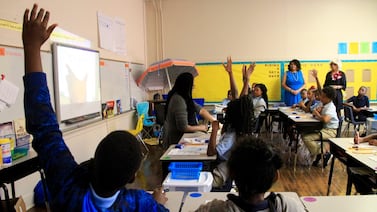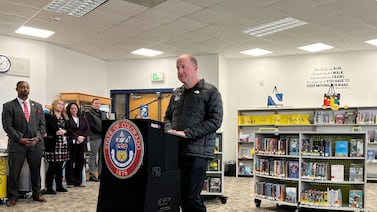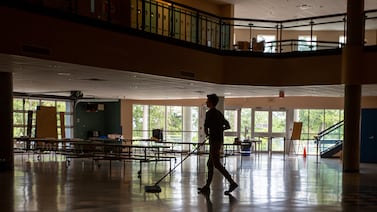Sign up for Chalkbeat New York’s free daily newsletter to get essential news about NYC’s public schools delivered to your inbox.
New York City’s public schools enrolled tens of thousands of new students during a wave of historic migration starting in 2022.
The surge transformed some campuses as educators adapted to meet the needs of children coming with limited English, trauma from their journeys, and little access to basics like food, clothing, and housing.
ATLAS, formerly known as Newcomers High School, in Long Island City, Queens, took in perhaps the largest number of new arrivals. Enrollment more than doubled in just three years, swelling to a high of 1,428 in the 2023-24 school year, compared to 676 in 2020-21, according to city data.
At P.S. 111, which sits amid a cluster of emergency homeless shelters blocks away from ATLAS, enrollment ballooned from under 300 to 564 in four years. After a 3,500-person migrant shelter opened in Clinton Hill, Brooklyn, enrollment at nearby P.S./I.S. 157 leapt from 250 to nearly 400 in a matter of months.
But over the last year, the boom came to an abrupt halt, a Chalkbeat analysis of preliminary enrollment data found. Citywide, enrollment fell 2%, the largest drop since the pandemic, with steeper declines at those schools that enrolled the most migrant students. Chalkbeat identified 60 schools that likely took in the largest shares of migrant students between 2022 and 2024. Combined, they lost 11% of their enrollment this year, nearly wiping out all the gains from the previous three years, the analysis found.
Chalkbeat’s analysis is the first attempt to systematically understand how migration has reshaped enrollment in the nation’s largest school district in recent years.
Like other cities across the country, New York City lost students as President Donald Trump’s mass deportation campaign drove some families to leave for fear of immigration enforcement — and dramatically slowed the pace of new arrivals. Compared to 2023, encounters at the U.S. southern border have plummeted by 77%, while the number of newcomers entering city shelters shrunk from a high of 4,000 a week to around 100.
Amid that slowdown, the number of new students registering in city schools this summer has fallen significantly: down 7% compared to the same period last year, Education Department officials said.
Federal enforcement efforts are not the only change that has contributed to the sudden shift in enrollment patterns. As Mayor Eric Adams attempted to deal with the surge, his administration enacted policies that made it difficult for migrant families to find stable housing, forcing many to switch schools or leave the city, educators and advocates said.
The enrollment reversal isn’t just a problem for individual schools, who may lose staffers and programs because school budgets are tied to student numbers. If the decline persists, as the city’s own projections predict, the Education Department will have to confront thorny questions about closing or merging underenrolled schools.
“That’s going to mean a big cut to the city’s federal funding, and that’s going to mean tough decisions for the NYC schools system as a whole, and that will trickle down to individual schools,” said Loredana Valtierra, a senior fellow at the Century Foundation and former official at the U.S. Department of Education.
At several of the schools that took in the most migrant students during the influx, enrollment has fallen just as dramatically as it rose.
The student headcount at ATLAS fell from over 1,400 to just 829 as of this fall, a 42% drop over two years. At P.S./I.S. 157 in Clinton Hill, enrollment cratered after the city closed the nearby migrant center in June — from nearly 400 last school year to 278 this fall, a 29% drop.
Though schools with big losses got a temporary reprieve from budget cuts this year if they fell short of enrollment projections, it’s not clear how long that support will last.
Lara Evangelista, the executive director of the Internationals Network, a nonprofit that supports city public schools geared toward newly arrived immigrants, said that schools were grateful to avoid midyear budget cuts, but she noted that principals will have to plan for the future. “What do you need to put in place this year to prepare for lower budgets going forward?”
Schools opened their doors to a historic influx of immigrant students
New York City enrolled an estimated 48,000 migrant students in a two-year period, officials have said, with many hailing from Latin America and West Africa.
City schools do not ask families for their immigration status or national origin, making it difficult to track enrollment of migrant students. But because many of the new arrivals took up residence in the city’s homeless shelters, Education Department officials used the number of homeless students newly enrolling in city schools as a proxy for migrant students.
To identify which schools took in the largest shares of migrant students, Chalkbeat compiled a list of schools with the biggest increases in both homeless students and English language learners, relative to their overall size, starting in 2022. Several education data experts said the approach was a reasonable way to approximate the number of new migrant students.
Migrant students often enrolled in schools near emergency shelters. Many of those were in midtown Manhattan and Long Island City in Queens, where officials converted hotels into shelters.
But enrollment patterns also depended on which schools had the space — along with the expertise and willingness — to take migrant students.
In East Harlem’s District 4, school and district leaders were “strategic” about opening their doors to newcomer families living in nearby Manhattan shelters, said Kaliris Salas-Ramirez, a parent in the district and president of its Community Education Council. The district had both space, after years of declining enrollment, and a large number of dual-language programs to offer.
The district’s share of English learners doubled from 9% to 18% between the 2022-23 and 2023-24 school years — the largest percentage jump in the city — leading to District 4’s first overall enrollment gain in at least a decade, according to city data.
Central Park East II, a K-8 school in East Harlem, took in roughly 100 newcomers, said Principal Naomi Smith. The school worked with district officials and partner organizations to connect families to free food and clothing, along with MetroCards and legal and emotional support, Smith said.
“I am proud of our school, our district, the [Education Department] in general for supporting our families,” she said. “I’m proud of what we do.”
NYC’s shelter policies threaten migrant enrollment
Some principals at schools with large migrant influxes anticipated the enrollment numbers would eventually level off as families left the shelter system, settling in different neighborhoods or leaving the city.
That accelerated in early 2024 when Adams — who said the pace of migration could “destroy the city” — began limiting stays in migrant shelters to 60 days to relieve an overburdened shelter system. Advocates and educators said the move made it difficult for families to remain in their schools and pushed some out of the city altogether as they struggled to find affordable housing.
“The piling on of one inconvenience after another made it impossible for people to stay at first in their school and then in the city,” said Naveed Hasan, a Panel for Educational Policy member who has supported schools with large numbers of new arrivals.
When Trump began his second term in January, his Justice Department pushed prosecutors to drop federal corruption charges against Adams, in part, so the mayor could aid the new administration’s immigration crackdown.
As the number of migrants in city shelters fell rapidly, city officials shuttered dozens of migrant shelters starting in early 2025. At some schools, the effect of the shelter closures was immediate.
P.S. 46 in Clinton Hill, Brooklyn, which was several blocks away from a 3,500-person mega-shelter that opened in summer 2023, took in dozens of migrant students in the 2023-24 school year.
After the shelter closed earlier this year, “many families and friends were separated and isolated,” said Carolina Zafra, a teacher at the school. Over the past year, enrollment has fallen by 16%, according to city figures.
At Central Park East II, some families have moved to schools closer to their new accommodations, or left the city for states like Texas and Florida, Smith said. Enrollment at the school is down about 40 students, or 10%, this year.
Across District 4, schools have seen a similar pattern, Salas-Ramirez said. Seven of District 4’s 29 schools saw enrollment drops of 15% or greater from last year to this one, according to Chalkbeat’s analysis. Districtwide, enrollment is down nearly 6%, the second-largest drop in the city.
In August, when city officials closed The Row hotel in midtown Manhattan, the last remaining large family migrant shelter, 138 families in East Harlem schools were displaced, she said.
“It’s been hard to track the families,” she said. “A lot of our principals and assistant principals have spent a lot of effort … just trying to figure out where they are.”
Trump’s immigration crackdown exacerbates enrollment losses
Attendance dipped among many immigrant families as Trump took office. Then, as immigration enforcement intensified in the spring, educators and advocates said they saw more families go into hiding or leave the country voluntarily to avoid being detained.
At least five city students have been detained by Immigration and Customs Enforcement, or ICE, though several have been released. Dylan Lopez Contreras, the first known city student detained by ICE during Trump’s second term, remains in detention in Western Pennsylvania six months after he was arrested during a routine court hearing. A judge denied Dylan’s asylum claim in September, and his lawyers have filed an appeal.
Schools across the city have also seen ICE sweep up students’ parents.
“People are leaving, or they’re staying in hiding,” said Power Malu, the co-founder of an aid group called ROCCNYC that has been helping connect migrant families with services since the beginning of the influx.
John Sullivan, the superintendent overseeing transfer schools for older students who have struggled in traditional high schools, said at a recent City Council hearing that his district has also seen a growing number of English learners leaving school for jobs. English learners have long dropped out of high school at higher rates than their peers, and some educators worry the pressure to earn money has increased as students worry they may have limited time in the U.S.
Despite the challenges, many educators are doing all they can to keep their newcomers.
Across schools in the Internationals Network, enrollment has largely stayed flat — a pattern Evangelista attributed in part to her schools’ strong relationships with families and ability to connect them to services, such as housing.
At East Harlem’s Central Park East II and Brooklyn’s P.S. 46, while some families displaced from their shelters have left, others still crisscross the city each day so they can stay enrolled, educators said.
Educators said the loss of a single student can reverberate across the entire school.
“Students are still really struggling,” said Valtierra, the Century Foundation fellow. “Having their friends and classmates not showing up … having to explain where those kids are going, that’s tough.”
Michael Elsen-Rooney is a reporter for Chalkbeat New York, covering NYC public schools. Contact Michael at melsen-rooney@chalkbeat.org





